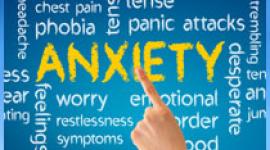Panic and Phobias in Children and Adolescents
 Detailed info on diagnosis and treatment of panic disorder and phobias in children and adolescents.
Detailed info on diagnosis and treatment of panic disorder and phobias in children and adolescents.
Panic attacks can occur in the context of several psychiatric conditions. A panic attack is a time-limited intense episode in which the individual experiences feelings of dread accompanied by physical sensations. Panic attacks usually average a couple of minutes but can last as long as 10 minutes and occasionally longer. Some really feel that they are about to die or have a serious medical problem. Children tend to have less insight than adults. Children may also be less articulate in describing their symptoms.
Common symptoms of a panic attack include:
- Chest pain
- Excessive perspiration
- Heart palpitations
- Dizziness
- Flushing
- Tremor
- Nausea
- Numbness in extremities
- Choking sensation or shortness of breath
- Feeling that one is not entirely in reality
- Extreme anxiety
- Fear that one is going to die
- Fear that one will become insane or lose control.
Panic Disorder is more likely to start in late adolescence or in adulthood. However, it can occur in children. The incidence of panic disorder with or without agoraphobia is lower than the incidence of simple phobia in children and adolescents.
Biederman and colleagues diagnosed panic disorder in 6% and agoraphobia in 15% of children and adolescents referred to a pediatric psychopharmacology clinic. Many of the children with panic disorder also had agoraphobia. The children with panic or agoraphobia had a high rate of co-morbid depression, and other anxiety disorders. However they also had a high incidence of disruptive behavior disorders such as Conduct Disorder and ADHD. The course of the panic disorder and agoraphobia appeared to be chronic.
Studies of adult panic disorder indicate that there is a high incidence of suicidal behavior, especially when it is accompanied by depression. Adults with panic disorder have an increased incidence of substance abuse. Thus one must look closely for the presence of other psychiatric disorders and make sure that the child or adolescent gets treatment. One should also screen for substance abuse.
A child with panic disorder should have a careful medical screening. It may be appropriate to screen for thyroid problems, excessive caffeine intake, diabetes and other conditions. Some sensitive individuals might have a panic-like reaction to certain asthma medications.
Treatment of panic disorder: Both medication and therapy have been used effectively. In children and adolescents with mild or moderate anxiety, it makes sense to start first with psychotherapy. If this is only partially effective, medication may be added. In children with severe anxiety or with co-morbid disorders, one might start therapy and medications simultaneously. Medications are similar to those used for adults. These would include SSRI medications (such as fluoxetine, fluvoxamine, , and paroxetine.) Individuals with panic disorder often respond to much lower doses of SSRIs, and may not do as well if started off with higher doses. Other medications used include beta blockers such as propranolol, the tricyclics (such as Nortriptyline), and occasionally the benzodiazepines (such as clonazepam.)
Psychotherapy: Individuals benefit from regular meals, adequate sleep, regular exercise and a supportive environment. One might teach the individual to use deep abdominal breathing and other relaxation techniques. Once real medical causes have been ruled out, the individual should remind himself that the symptoms are frightening but not dangerous. The person should learn to label the episode as a panic attack and understand it as an exaggeration of a normal reaction to stress. The person should not try to fight the episode, but should simply accept that it is happening and is time limited. Some learn to go outside themselves and rate the symptoms on a scale of 1-10. The individual should be encouraged to stay in the present and notice what is going on in the here and now.
If agoraphobia is present, the child should make up a hierarchy of fear-inducing situations. With help from parents and therapists, the child should move up the hierarchy of feared situations.
Simple Phobias in Children
Simple phobias are fairly common in children. Phobias often begin in childhood. Many do not cause significant life impairment and thus would not meet criteria for a formal psychiatric diagnosis. Milne et al found 2.3% of young adolescents in a community sample met criteria for a clinical phobic disorder. However, a much larger number, 22% had milder phobic symptoms. Girls had a higher rate than boys, and African Americans had a higher rate than Caucasians. Individuals with more severe phobias were more likely to have other psychiatric diagnoses than those with milder phobias.
The therapist should work with a parent or other responsible adult to gradually desensitize the child to the feared object. Relaxation training is helpful here too.
References
- Biederman, J et al, Panic Disorder and Agoraphobia in Consecutively Referred Children and Adolescents, Journal of the American Academy of Child and Adolescent Psychiatry, Vol. 36, No. 2, 1997.
- Clark, D.B. et al, Identifying Anxiety Disorders in Adolescents Hospitalized for Alcohol Abuse or Dependence, Psychiatric Services, Vol. 46, No. 6, 1995.
- Milne, J.M. et al, Frequency of Phobic Disorder in a Community Sample of Young Adolescents, Journal of the American Academy of Child and Adolescent Psychiatry, 34:9-13. 1995.
next: Post-Traumatic Stress Disorder Common Among Children in Auto Crashes
~ anxiety-panic library articles
~ all anxiety disorders articles
APA Reference
Tracy, N.
(2007, February 17). Panic and Phobias in Children and Adolescents, HealthyPlace. Retrieved
on 2025, December 11 from https://www.healthyplace.com/anxiety-panic/articles/panic-and-phobias-in-children-and-adolescents



